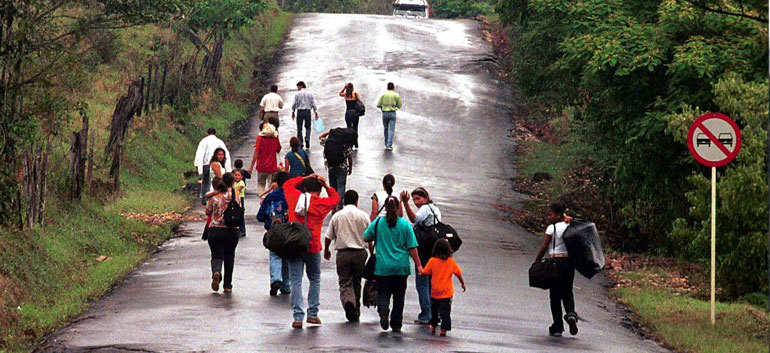At least 12% of Colombia’s 47 million people are victims of forced displacement, according to an Internal Displacement Monitoring Centre (IDMC) report published Wednesday.
Of the approximately 6.3 million people in Latin America who have been forced to flee their homes due to war or violence, 5.7 million were Colombian. Colombia, still embroiled in a complicated 50-year armed conflict between leftist guerrillas, the state, and right-wing paramilitary groups, was one of the five countries that accounted for 78% of the world’s total living displacement victims as of 2013, according to the IDMC. The IDMC pointed out that its statistics do not take into account the many Colombians killed or “disappeared” during armed conflict.
The “Global Overview” report did mention, however, that the Andean nation has made significant progress as compared to the blood-soaked years of the early 2000s, calling Colombia an “encouraging example” for other similarly troubled countries. At the turn of the century, Colombia was producing roughly 300,000 new displacements per year, a number that has dropped to 180,000 over the course of the past five years.
Many of the incidents in Colombia are “mass displacements,” meaning a group of more than ten families or 50 people from the same area. According to reports by local UNHCR field offices, between January and June 2013, there were 61 reported large group displacements in the country. Up until April, only six of these group displacements were registered by the government’s Victims’ Unit, affecting 3,685 families.
More than 33% of the people displaced in recent years fled from the Pacific Coast, home primarily to indigenous and Afro-Colombian populations, which are disproportionately affected by the armed conflict.
The majority of flight is from rural to urban areas, but new IDMC data indicates a rise in “intra-urban” flight as well, especially in the cities of Medellin, Cali, and Buenaventura. The situation in Buenaventura in particular was recently deemed a humanitarian crisis by Human Rights Watch for extreme human rights abuses, including abductions and dismemberment as well as mass displacement.
MORE: Buenaventura leader in urban discplacement: NGO
According to the “Global Overview,” the majority of Colombia’s displacement is still caused by the armed conflict between guerilla groups and government forces, though “re-emerged paramilitaries and organized crime syndicates also commit significant abuses and violence against civilians.” Over 37 human rights workers were reportedly assassinated by neo-paramilitary organizations such as “Los Urabeños” in the first half of 2013 alone.
The report adds that “widespread abuses, including the recruitment of minors, sexual violence, the use of anti-personnel mines, extortion, and the targeting of human rights workers have also forced people from their homes.”
The Americas report, which also presents data on displacement in Mexico, Honduras, Guatemala, and Peru, says that Colombia has made the most progress in integrating internally displaced peoples (IDPs) locally or returning them to their homes. The IDMC also acknowledges that the Colombian government has continued with an “unprecedented” land restitution process for victims of the armed conflict, but adds that actual reparations have been minuscule, when compared to the ongoing wreckage produced by internal violence.
Colombia’s 2011 Victims and Land Restitution Law, which allows victims of armed conflict a legal basis for financial restitution, and its subsequent constitutional amendment in 2013 to include victims of organized crime and post-demobilization paramilitary groups (GPDP), was singled out as a prime example of a legal framework being implemented to adress the problem of IDM.
MORE: Colombia court orders legislators to amplify Victims Law
The largest obstacle facing the Colombian government, according to the report, is the violent backlash directed against land restitution by armed groups, putting many people in fear of reporting displacement. Many who do file reports are threatened and targeted by these same groups, resulting in a decrease in the number of restitution claims by victims.
The report concludes by saying that only a small percent of the “substantial amount” of international assistance Colombia receives for internally displaced peoples actually goes to humanitarian needs.
“Even given the best-case scenario in which Colombia reaches a peace agreement with the FARC, [the country’s largest rebel group, which has been negotiating a peace settlement with the Colombian government since November 2012] persistent insecurity and criminality will require a long-term international commitment to the country.”
Sources
- Global Overview 2014: people internally displaced by conflict and violence (IDMC Report)
- 2014 UNHCR country operations profile – Colombia (UNHCR Website)
- Todas las víctimas del conflicto: más derechos y más retos (Razon Publica)


